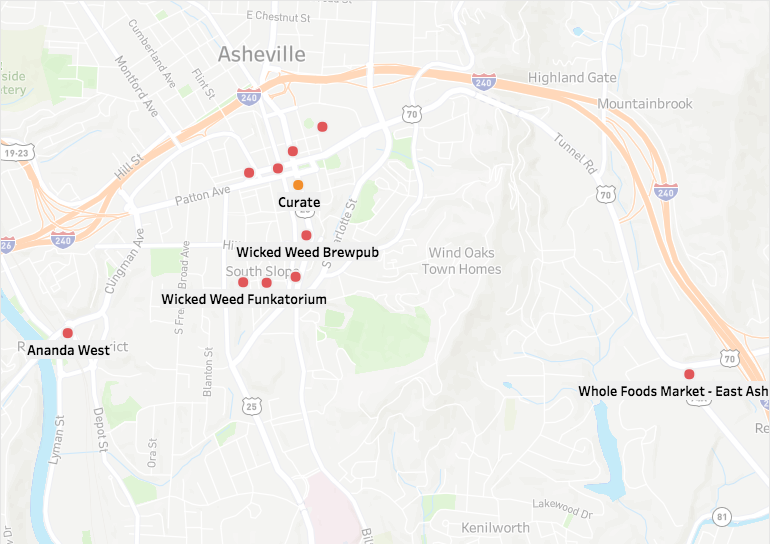


Local government officials have pointedly refused to ever name the locations of outbreaks at Asheville workplaces. So we are
Tourism hubs are ripe for pandemics. Travel, bars, indoor dining and hotels are all some of the industries that spread a disease farthest and fastest. As an airborne virus that primarily infects through person to person proximity, COVID-19 loves businesses that bring people from a range of areas together in confined spaces with workers that are frequently forced to come in sick.
But just as the first confirmed cases were hitting Asheville acting Buncombe County health director Jennifer Mullendore made an odd announcement. She declared that local public health officials would never name the locations of outbreaks at businesses.
“It is not best practice, or beneficial, to notify the public of the locations that a person with an illness like COVID-19 visited during the time they had symptoms,” Mullendore told the public on March 23 of last year. “The concern is that public notification causes increased public anxiety and does not assist in the identification of new cases.”
That remained the policy even as the virus spread, cases skyrocketed and people died. Some news of outbreaks have trickled out anyway. Word of mouth, workers who courageously spoke up, social media posts and even the occasional news article. But this information remained scattered, leaving people without a clear idea of the virus’ spread or the businesses that often endangered workers and the public in their quest for profits. Despite all this local governments still adamantly refuse to name the locations of outbreaks.
So we are.
Below is a map of known COVID outbreaks at businesses in Asheville and the surrounding county. They’re marked in red. The map also warns of businesses particularly known for ignoring, actively defying or denouncing basic public health precautions, even if an outbreak hasn’t yet been confirmed. Those are marked in yellow.
Here’s a link to the map as well.
The Blade and other locals assembled this by combing through months of posts and talking to workers around the area. The outbreaks range from the first months of the pandemic to the past few weeks. They take place everywhere from corporate chains owned by the world’s richest man to local businesses whose concern for the community apparently didn’t extend to taking basic steps to prevent people from getting sick and dying.
We’re also going to update this map as new information and outbreaks emerge.
Much more is needed, as the outbreaks reported here are obviously a fragment of the tip of the iceberg. If you have direct knowledge of an outbreak, you can share your information with us anonymously so we can add it to the map. That can be about a current outbreak, a past one or a business that is being particularly dangerous in its lack of concern for public health. If you want to quickly share information about this map and how people can add to it, here’s a handy flier:
This is necessary because the official fretting about “public anxiety” means nothing more than “we don’t want bad headlines for the tourists.” Combined with shutting down non-essential activities, widespread testing and contact tracing, public alerts are a vital part of containing a disease. As people in everywhere from grocery stores to restaurants don’t know most of the people they’re around, contact tracing is virtually impossible. Even North Carolina state law requires public announcements of outbreaks at long-term care facilities. Plenty of places around the country do them for outbreaks at all types of businesses. Informing people that they may have been exposed and need to quarantine if they were in a certain place at a certain time is a major public health tool.
Here’s one example, from New York, of a local health agency doing what Buncombe’s has claimed is impossible:
But from the start the priority of city and county governments hasn’t been public health. Instead, it’s been protecting business owners’ profits, especially those of the tourism industry. Cases and deaths started rising sharply after the county removed restrictions on hotels in late June, but they still refused to alert the public. Over the coming months they would literally encourage people to go shopping even as things kept getting worse. At every step of the way the wishes of hoteliers, wealthy restaurateurs and tourism barons has come before the health of the people who live and work here.
Refusing to name the location of outbreaks also left local governments a handy excuse. Just like case numbers technically go down if testing stops, it’s harder to tie outbreaks to specific businesses or industries if governments intentionally bury the information. Indeed, despite massive evidence from public health studies around the world that indoor dining is particularly dangerous, the lack of the information on specific local outbreaks was used by restaurant owners and a compliant press to push for opening up more indoor dining in January.
Tourism is killing us. But true to form those in power demands our silence as it does so. We refuse. We will tell the truth. We will support each other. We keep us safe.
—
Blade editor David Forbes has been a journalist in Asheville for over 15 years. She writes about history, life and, of course, fighting city hall. They live in downtown, where they drink too much tea and scheme for anarchy.
The Asheville Blade is entirely funded by our readers. If you like what we do, donate directly to us on Patreon or make a one-time gift to support our work. Questions? Comments? Email us.